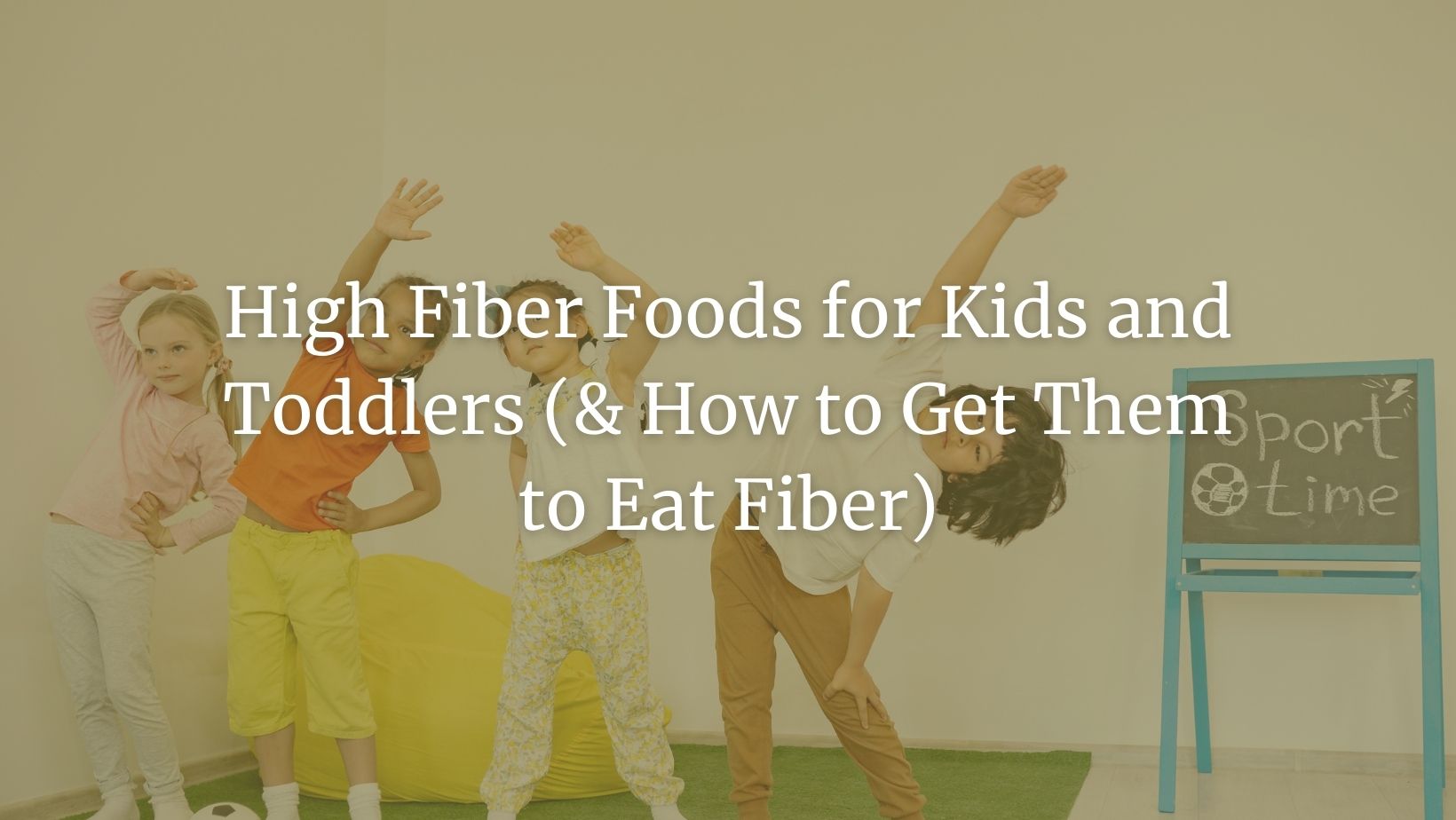High Fiber Foods for Kids and Toddlers (& How to Get Them to Eat Fiber)
As a caring parent, you want the best for your child’s health and overall well-being. Nutrition plays a crucial role in their growth and development, and one essential component often overlooked is fiber.
In this article, we’ll talk about the variety of high-fiber foods for kids that you can introduce into their diet – and we will also go over the importance of fiber in their diet. We will explore the importance of fiber for kids and toddlers, and provide you with a variety of delicious and kid-friendly high fiber food options to incorporate into their diets.
Fiber is a nutrient that offers numerous health benefits, such as promoting digestion, maintaining a healthy weight, and reducing the risk of chronic diseases. This is why prioritising it in your child’s (and your own) diet is an essential aspect of a healthy eating plan.
Why Fiber Matters for Kids and Toddlers
Let’s begin by going over what fiber is and then discuss it’s health importance:
Fiber is a type of carbohydrate that cannot be digested by the body, but it plays a vital role in maintaining a healthy digestive system.
It adds bulk to stools, preventing constipation, and ensures regular bowel movements. Additionally, fiber helps regulate blood sugar levels, keeping your child’s energy stable throughout the day and reducing the risk of developing type 2 diabetes. And, while humans can’t digest fiber, the bacteria in their gut can – this makes a fiber-rich diet the cornerstone of maintaining a healthy microbiome, which affects a variety of body functions, from immunity to mental health.
Fiber-rich foods also promote satiety, making your child feel fuller for longer periods. This can be particularly beneficial for weight management and reducing the likelihood of overeating or indulging in unhealthy snacks. Moreover, consuming an adequate amount of fiber is associated with a lower risk of heart disease and certain types of cancer later in life.
Fiber supplementation isn’t the best way to hit your child’s fiber needs. But, if you’re taking those supplements yourself, take some time to learn about the best time for a fiber supplement in our dedicated article.
How Much Fiber Do Kids and Toddlers Need?
The recommended daily intake of fiber varies depending on your child’s age. What is more, different organisations have slightly varying recommendations
According to the Dietary Reference Intake:
For toddlers aged 1 to 3 years, aim for about 19 grams of fiber per day. As your child grows older, the fiber requirements increase gradually.
Children aged 4 to 8 years should consume around 25 grams of fiber daily, while older children and teenagers (9 to 18 years) should aim for approximately 31 grams per day.
There is an additional set of suggestions by the American Academy of Paediatrics who suggest fiber intake should be:
- The age of the child in years + 5 g (so for a two-year-old it would be 7g)
- 0.5 g fiber/(kg body weight meaning a child that weighs 20kg should get about 10g of fiber
- Up to 35 g of fiber per day
As you can see, the AAP recommendations suggest less fiber than the DRI ones. And, even so, most American children fail to meet this dietary requirement, which may put them at risk of disease and weight gain.
So, to encourage your child to eat more fiber and help them hit their suggested intake, here are some foods you can incorporate:
High Fiber Foods for Kids and Toddlers
Young children can be picky eaters, so it’s important to offer them a variety of fiber-rich options. Not only will this help you find what your child prefers, but it comes with additional nutritional benefits such as enhanced gut health (the microbiome loves diversity in diet).
Here are the main groups of high-fiber foods to explore with your little one:
- Fruits and Vegetables:
- Include a variety of colorful fruits and vegetables in your child’s diet. Apples, pears, berries, oranges, bananas, carrots, cucumbers, broccoli, and sweet potatoes are excellent sources of fiber.
- Serve sliced fruits as a refreshing snack or blend them into smoothies for added nutrition. Include vegetables in stir-fries, soups, or even sneak them into homemade sauces.
- Whole Grains:
- Opt for whole grain cereals, bread, and pasta instead of their refined counterparts. Look for labels that mention “whole wheat,” “whole grain,” or “whole oats.”
- Prepare oatmeal, whole grain pancakes, or whole wheat sandwiches to add more fiber to your child’s diet.
- Legumes and Beans:
- Kidney beans, chickpeas, lentils, and black beans are packed with fiber and essential nutrients. Introduce them gradually to your child’s meals, such as in soups, stews, or as a side dish.
- Create a fiber-rich chili by incorporating various beans and vegetables.
- Nuts and Seeds:
- Almonds, walnuts, chia seeds, and flaxseeds are excellent sources of fiber. Offer them as snacks or sprinkle them over salads, yogurt, or cereal to boost fiber content.
- Smoothies and Snacks:
- Prepare fiber-rich smoothies using a combination of fruits, vegetables, yogurt, and a handful of spinach or kale. This is a great way to sneak in additional nutrients without your child even realizing it.
- Opt for whole grain crackers, air-popped popcorn, or homemade granola bars as healthy and fiber-packed snack options.
Incorporating high fiber foods into your child’s diet is a simple and effective way to promote their overall health and well-being. By offering a variety of fruits, vegetables, whole grains, legumes, and seeds, you can ensure they meet their daily fiber requirements.
Be patient when introducing new foods and flavors, and involve your child in meal planning and preparation to increase their interest and enjoyment. It’s also helpful to model good eating behaviours yourself. If you want to encourage your child to eat more fruit and veggies, incorporate them in your own diet, too.
Delicious and Kid-Friendly High Fiber Meal Options
So, what are some food options you can try at mealtime to encourage your little ones to get more fiber? Here are our favorite options, sorted by meal type:
- Fiber-Rich Breakfast Ideas:
- Overnight Oats: Prepare a batch of overnight oats using rolled oats, chia seeds, and milk (dairy or plant-based). Add a handful of berries and a drizzle of honey for natural sweetness. This fiber-packed breakfast will keep your child energized throughout the morning.
- Whole Grain Pancakes: Swap traditional pancakes with whole grain pancakes made from whole wheat flour or a combination of whole wheat and oat flour. Serve them with sliced bananas or blueberries and a dollop of Greek yogurt for added protein and fiber.
- Wholesome Lunch and Dinner Options:
- Veggie Pasta: Use whole wheat or chickpea pasta and toss it with a flavorful vegetable-packed sauce. Blend cooked tomatoes, onions, garlic, carrots, and spinach to create a nutritious sauce. Top it off with grated cheese for added taste and calcium.
- Quinoa Salad: Cook quinoa according to package instructions and let it cool. Mix it with colorful diced vegetables like bell peppers, cucumbers, cherry tomatoes, and black beans. Drizzle with a lemony vinaigrette dressing and sprinkle some feta cheese on top. This fiber-rich salad is not only delicious but also great for lunchboxes.
- Snack Time Favorites:
- Fruit and Yogurt Parfait: Layer Greek yogurt, fresh fruits, and a sprinkle of granola or crushed nuts in a glass or jar. This delightful snack provides a combination of fiber, protein, and vitamins.
- Ants on a Log: Spread peanut butter or almond butter on celery sticks and top them with raisins. This classic snack is not only fun for kids but also a great source of fiber and healthy fats.
- Hydrating and Fiber-Filled Beverages:
- Smoothie Bowls: Blend a combination of frozen fruits, spinach or kale, a spoonful of nut butter, and a liquid of your choice (milk, coconut water, or fruit juice). Pour the smoothie into a bowl and top it with sliced fruits, chia seeds, and granola. This refreshing and fiber-rich treat is perfect for warm days.
- Infused Water: Encourage your child to drink more water by infusing it with sliced fruits like oranges, berries, or cucumbers. This naturally flavored water is not only hydrating but also provides a hint of sweetness and a touch of fiber.
Remember to make the child a part of the meal planning and food prep process. Let them choose their favorite fruits and vegetables, and encourage them to try new flavors. By making mealtimes fun and engaging, you can foster a positive relationship with food and encourage healthy eating habits.
Conclusion
Incorporating high fiber foods into your child’s diet doesn’t have to be a challenge. By using these delicious and kid-friendly meal options, you can ensure your child receives the necessary fiber for their growth, development, and overall health. Remember to gradually introduce new foods, be patient, and lead by example.
By prioritizing fiber-rich foods, you are empowering your child to make nutritious choices and lay the foundation for a lifetime of good health. Stay tuned for more articles on nutrition and health for your little ones.
References
- Institute of Medicine Dietary Reference Intakes for energy, carbohydrate, fiber, fat, fatty acids, cholesterol, protein, and amino acids. Washington, DC: National Academies Press; 2002/2005 [PubMed] [Google Scholar]
- Moshfegh A, Goldman J, Cleveland L. What we eat in America, NHANES 2001–2002. Usual nutrient intakes from food compared to Dietary Reference Intakes. Beltsville, MD: USDA, Agricultural Research Service; 2005 [Google Scholar]
- Gemen R, de Vries JF, Slavin JL. Relationship between molecular structure of cereal dietary fiber and health effects: focus on glucose/insulin response and gut health. Nutr Rev. 2011;69:22–33 [PubMed] [Google Scholar]
- Johnson L, Mander AP, Jones LR, Emmett PM, Jebb SA. Energy-dense, low-fiber, high-fat dietary pattern is associated with increased fatness in childhood. Am J Clin Nutr. 2008;87:846–54 [PubMed] [Google Scholar]
- Sibylle Kranz, Mary Brauchla, Joanne L. Slavin, Kevin B. Miller. What Do We Know about Dietary Fiber Intake in Children and Health? The Effects of Fiber Intake on Constipation, Obesity, and Diabetes in Children, Advances in Nutrition, Volume 3, Issue 1, 2012, Pages 47-53, ISSN 2161-8313, https://doi.org/10.3945/an.111.001362 (https://www.sciencedirect.com/science/article/pii/S2161831322009668)







